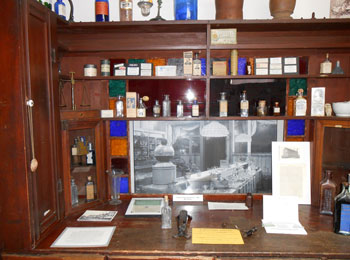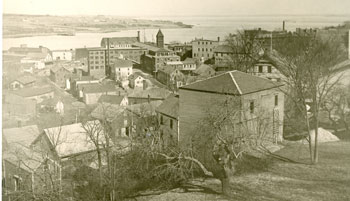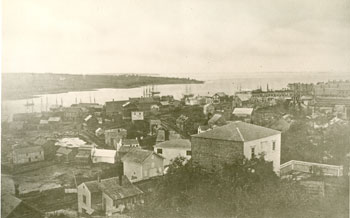A History of Belfast – Part II
by Tom Seymour

Poor’s Drug store came on the scene in 1814. An early photo of the store’s interior is at center of the display. 1829 saw the debut of the Republican Journal, a weekly newspaper that continues to this day. And in 1854, Matthews Brothers Sash, Blind & Door Factory opened for business and remains so today. Photo courtesy Belfast Historical Society.
Shortly after the opening salvos of the American Revolution were fired in Lexington and Concord, Belfast, Maine, formed a committee of safety. Never fond of British rule, the Scots-Irish settlers quickly displayed their patriotic bent.
Committees of safety had sprung up throughout the colonies. These were composed of volunteers who had the unenviable task of acting in the best interest of the Colonial cause, but without much guidance or without a frame of reference as to how to do so. That they did as well as they did speaks volumes for their integrity.
When news of events in Boston, notably Bunker Hill, reached Belfast, young men from the settlement began the trek southward to join the Revolutionary cause. Then, in 1776, the local militia was activated and every healthy male between ages 16 and 60 was required to participate.
Then, in 1777, the armed British schooner, Margaretta, sailed into Machias. Seeing a liberty pole, the British captain came ashore and ordered the pole removed, or he would fire upon the town. The citizens of Machias voted to let their liberty pole stand. This compelled Machias to hatch a plan of attack that ended in a group of Machias men boarding and capturing the enemy vessel.
After this, fear of repercussion flew up and down the coast and consequently, several militia companies were directed to travel to Machias to protect against another expected attack. Belfast men served in this manner from mid-August through mid-September. These were: Tolford Durham, John Durham, David Gilmore and James Miller.
Penobscot Expedition
In June, 1779, a British fleet sailed into Bagaduce Harbor and invested the village of Castine. Troops landed at the foot of today’s Main Street without opposition. After the troops were quartered, the British commander General McLean began fortifying the peninsula, something that resulted in the construction of Fort George, earthworks of which remain to this day. Castine, by the way, sits approximately eight miles across Upper Penobscot Bay from Belfast. Residents of Belfast have an unobscured view of Castine.
Additionally, McLean announced that all male residents take an oath of allegiance to the British crown or suffer the consequences. News of this soon reached Belfast and the residents reacted with much consternation. Many abandoned their homes rather than submit to this indignation, while others saw no way out but to sign the hated oath.
In response to British activities in Castine, the Massachusetts General Court organized a military expedition to drive the British from the region. This was known as the Penobscot Expedition. The attack ended in disaster for the American forces. And because of their clear view across the bay, Belfast citizens stood spellbound as they witnessed, and heard, the battle.
In addition to watching events unfold across the bay, Belfast sent men and boats across to participate in the venture. Some of these men had previously signed the oath of allegiance to Britain, but this attack upon Castine, they reasoned, made their oaths null and void.
At the end of this, America’s first and for many years, worst, naval disaster, Belfast was again in a state of dismay. American vessels were everywhere on the bay, fleeing from the pursuing British. At that point, many of the Belfast men who had left to fight at Castine found their way home.
Having violated their newly-given oath of allegiance to Britain, the Belfast men feared not only for their own lives but also for their families. It seemed quite probable that British retaliation would come swiftly and without mercy. These events precipitated the evacuation of Belfast. Families packed what household belongings they could carry and fled to neighboring towns.
It was well that Belfast people fled, since the British made various sallies from Castine, where they destroyed property and impounded cattle and other items. When, in 1780, Belfast people began trickling back, they found a comparative wasteland, with the place as they knew it effectively destroyed.
War ended in 1783 and in 1784, the Massachusetts General Court approved a petition for Belfast to receive an abatement for taxes left unpaid after the place was evacuated.

Belfast 1912. Belfast continued as a manufacturing town until into the third quarter of the 20th century. From its inception, Belfast grew and continues slow, but steady growth to the current time. In 1800, the population was 674 souls. By 1900, Belfast had grown to 4,615 and by 2000, the population of Belfast hit 6,381. Photo courtesy Belfast Historical Society.
Belfast Booms
The 19th century saw tremendous growth in every arena. Belfast was settled by intelligent, industrious, creative and enterprising people and their efforts bloomed around the turn of the 19th century.
The War of 1812 touched Belfast, Maine, only lightly. Once again, as in the past war, the British took and held Castine. On September 1 of that year, a forest of masts appeared in the bay, one witness likening the scene to seeing a spruce swamp.
At this sight, the local militia retreated to the safety of neighboring Belmont. The British landed and gave the inhabitants of Belfast to believe that if they did not fire upon the troops, and if Belfast provided food and shelter, the redcoats would leave the town unmolested. The British departed Belfast a week later, on September 7. They kept their word and did no harm.
The British made one more appearance in Belfast, a friendly one, that same winter, where they held a ball at Whittier’s Tavern. The following verse serves as a lasting memento of the British coming to Belfast in 1814:
“On the first of September,
The English we’ll remember”
Of note, the place where the British held their ball, was typical of the grand architecture that had begun to dominate the Belfast landscape. Many of these 19-th century homes are listed in the National Register of Historic places. Greek-revival mansions and Federal-style architecture abounds. A walking tour of the city takes the viewer past many of these and The Museum In The Streets program has posted informational signs at prominent points along the walk.
The harbor and waterfront became magnets for industry and merchants and shipbuilders thrived. Whereas in the 18th century, only 12 vessels were registered as having been built in Belfast, in the 1820-1829 period, 51 were built. The industry expanded until between 1850 and 1859, 153 new ships slid off the stays at Belfast area shipyards.
By 1868, the waterfront and shoreline of the Passagassawaukeag River was lined with wharves and shipyards; 26 of the former and six of the latter.
The Civil War saw much energy diverted to the war effort and from 1860 through 1869, 57 ships were built. By the late 1800, the age of the steamship took its toll on builders of sailing vessels. From 1880 to 1899, a total of 90 vessels were built in Belfast. By the end of that era, shipbuilding had nearly ended. Between 1910 and 1920, 3 more vessels were built in Belfast. This was the period at the end of a proud and long-lived sentence of Belfast history.

Belfast 1869. Looking east across the Pegassawsskeag River. Castine across the bay on the horizon in the distance at right. The harbor and waterfront became magnets for industry and merchants and shipbuilders thrived. By 1868, the waterfront and shoreline of the Passagassawaukeag River was lined with wharves and shipyards; 26 of the former and six of the latter. Photo courtesy Belfast Historical Society.
Belfast Merchants
A brief timeline gives examples of Belfast’s continuing growth in the 19th century. Poor’s Drug store came on the scene in 1814. In 1818, the Custom House and First Church (with it’s Revere bell) were built. In 1827, Belfast was named the county seat. 1829 saw the debut of the Republican Journal, a weekly newspaper that continues to this day. And in 1854, Matthews Brothers Sash, Blind & Door Factory opened for business. Matthews Brothers remains a viable and expanding business today.
By the 1880s, the Kelly Axe Factory produced 144 axes daily. In 1887, Hersey & Woodward Clothing Company shipped 200 tons of goods, showing that Belfast was in the process of supplying the rest of the country with its goods. Dana Sarsaparilla began in 1888 and by 1892, produced 500,000 bottles between January and June of that year.
Belfast excelled in inventions and in the last quarter of the 19th century, saw more than 25 patents issued to Belfast residents. These inventions were often for general use, such as a flush tank for waterclosets and even a washing machine. Others were for more specific uses.
For instance, the Hazeltine family of Belfast had immersed themselves in the hay trade by exporting that commodity. The Hazeltines shipped hay to Jacksonville, Florida. This business lasted for several generations. Accordingly, Belfast warehouses and wharves brimmed with hay for the export trade. The Hazeltines were known as the biggest exporters of hay.
But keeping loose hay (hay bales were not yet invented) within manageable bounds was problematical. So a Belfast man invented a hay lever press that compounded the hay and squeezed it into tight packs.
This hay business, by the way, had one less-than-salutary effect upon Belfast. Hay was, and is, extremely flammable. Fires were common and the downtown section was frequently wreathed in smoke for weeks at a time, until the last smoldering embers were finally extinguished.
Twentieth Century
Belfast continued a manufacturing town until into the third quarter of the 20th century. By then, a different set of economics took hold and the old way of life came to an end.
From its inception, Belfast grew and continues slow, but steady growth to the current time. In 1800, the population was 674 souls. By 1900, Belfast had grown to 4,615 and by 2000, the population of Belfast hit 6,381.
